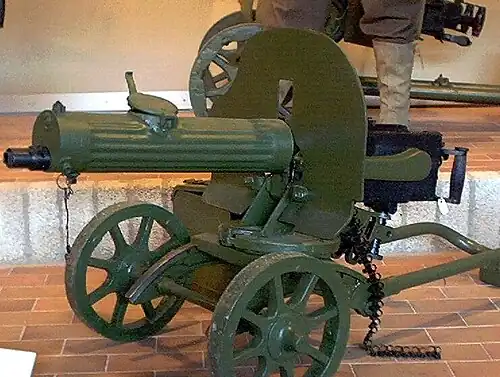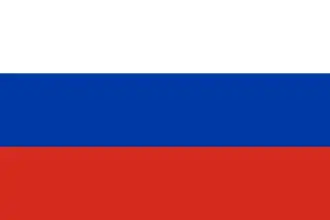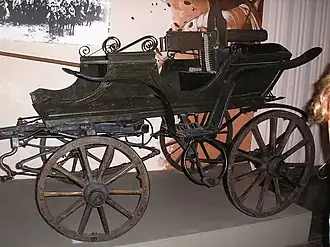PM M1910
| Pulyemyot Maksima obr. 1910 | |
|---|---|
 PM M1910/30 | |
| Type | Heavy machine gun |
| Place of origin | Russian Empire[1] |
| Service history | |
| In service | 1910 – Present |
| Used by | See § Users |
| Wars | See § Conflicts |
| Production history | |
| Designed | 1909 – 1910[2] |
| Manufacturer | Tula Arsenal |
| Developed from | Maksima obr. 1905 |
| Produced | 1910 – 1939 1941 – 1945 |
| No. built | At least 176,000[3] Up to 600,000[4] |
| Variants | See § Variants |
| Specifications | |
| Mass |
|
| Length | 1,067 mm (42.01 in) |
| Barrel length | 721 mm (28.39 in) |
| Cartridge | 7.62×54mmR[1][5] |
| Caliber | 7.62 mm |
| Action | Short recoil, toggle locked |
| Rate of fire | 600 round/min[1] |
| Muzzle velocity | 740 m/s (2,400 ft/s) |
| Effective firing range | 2,700 m (3,000 yd)[4] |
| Maximum firing range | 5,000 m (5,500 yd)[4] |
| Feed system | 250-round belt[1] |
The Pulyemyot Maksima M1910 (Russian: Пулемёт Максима образца 1910 года, romanized: Pulemyot Maksima obraztsa 1910 goda, lit. 'Maxim machine gun model 1910'), or PM M1910, is a heavy machine gun based on the Maxim gun, that was used by the Imperial Russian Army, Navy and Air Service during World War I, then by the Red, White and Green armies during the Russian Civil War, and later by the Soviet Armed Forces during World War II. Later the gun saw service in the Korean War, the Vietnam War and the 2022 Russian invasion of Ukraine.
History
It was adopted in August 1910 and was derived from Hiram Maxim's Maxim gun, chambered for the standard Russian 7.62×54mmR rifle cartridge. The M1910 was mounted on a wheeled mount with a gun shield.[5]
In 1918–1920, 21,000 new Maxim M1910 machine guns were manufactured in Revolutionary Russia for the Red Army.[1] In 1930, a modernized version M1910/30 was adopted by the Red Army.[5] M1910/30 can be equipped with optical sight.[6] In 1941, the gun was modernized once again.[5] In May 1942, an order was given to begin the development of a new machine gun to replace the Maxim M1910/30. On May 15, 1943, the SG-43 machine gun was adopted and since summer 1943 Maxim guns were replaced in Soviet service by the SG-43, which retained the wheeled and shielded carriage. However, production of the Maxim did not end until 1945.[5]
In addition to the main infantry version, there were aircraft-mounted and naval variants. Some were fitted with a tractor radiator cap fitted on top of the water jacket to allow handfuls of snow to be packed in to melt while firing.
After World War II, the Maxim was phased out of service, but was still sent in some quantities to the Korean War and Vietnam War. In 2014 during the war in Donbas, some Maxims in stock were captured by the Pro-Russian separatists while others were taken from storage to be used by the Ukrainian Armed Forces.[7] A number were used by the Ukrainian military during the 2022 Russian invasion of Ukraine due to their reputation for accuracy and reliability.[8]
Variants
Gun variants
- Russian Empire/Soviet Union
- Maxim M1910 — Maxim gun based on the Maxim-Vickers Model 1906 with a corrugated-type water jacket.
- Maxim M1910/30 —
- Maxim–Tokarev — Air-cooled light machine gun derivative of the M1910.
- PV-1 — Soviet air-cooled version of the M1910 for mounting on aircraft.
- Second Polish Republic
- Maxim wz. 1910 — Polish Maxim M1910.[11]
- Maxim wz. 1910/28 — Polish Maxim wz. 1910 converted to 7.92 mm Mauser.[11]
Designations
- Russian Empire
- Maxim M1910 MG on the Sokolov M1910 wheeled mount (Russian: Пулемёт Максима образца 1910 года на колёсном станке А. А. Соколова образца 1910 года, romanized: Pulemyot Maksima obraztsa 1910 goda na kolosnom stanke A. A. Sokolova obraztsa 1910 goda, lit. 'Maxim machine gun model 1910 on the A. A. Sokolov wheeled mount model 1910')[2]
- Maxim M1910 MG on the Kolesnikov M1915 wheeled mount (Russian: Пулемёт Максима образца 1910 года на колёсном станке И. Н. Колесникова образца 1915 года, romanized: Pulemot Maksima obraztsa 1910 goda na kolosnom stanke I. N. Kolesnikova obraztsa 1915 goda, lit. 'Maxim machine gun model 1910 on the I. N. Kolesnikov wheeled mount model 1915')[2]
- Soviet Union
- Maxim M1910 MG on the Kondakov M1928 anti-aircraft tripod (Russian: Пулемёт Максима образца 1910 года на зенитной треноге М. Н. Кондакова образца 1928 года, romanized: Pulemyot Maksima obraztsa 1910 goda na zenitnoy trenoge M. N. Kondakova obraztsa 1928 goda, lit. 'Maxim machine gun model 1910 on the M. N. Kondakov anti-aircraft tripod model 1928')[2]
- Maxim M1910/30 machine gun on the Vladimirov M1931 wheeled mount (Russian: Пулемёт Максима образца 1910/30 года на колёсном станке С. В. Владимирова образца 1931 года, romanized: Pulemot Maksima obraztsa 1910/30 goda na kolosnom stanke S. V. Vladimirova obraztsa 1931 goda, lit. 'Maxim machine gun model 1910/30 on the S. V. Vladimirov wheeled mount model 1931')[2]
- M-4 quadruple anti-aircraft machine gun mount (Russian: Счетверённая зенитная пулемётная установка М-4 образца 1931 года)[2][12]
Users
.svg.png) Austria-Hungary — Seized during World War I.[13]
Austria-Hungary — Seized during World War I.[13] Bulgaria[14]
Bulgaria[14] China[15]
China[15] Czechoslovakia — In January 1942, the first twelve Soviet Maxim 1910/30 machine guns were given from USSR to 1st Czechoslovak Independent Infantry Battalion, later additional quantity was given to other units of the 1st Czechoslovak Army Corps.[16]
Czechoslovakia — In January 1942, the first twelve Soviet Maxim 1910/30 machine guns were given from USSR to 1st Czechoslovak Independent Infantry Battalion, later additional quantity was given to other units of the 1st Czechoslovak Army Corps.[16] Finland[9][10][17]
Finland[9][10][17].svg.png) German Empire — A quantity of machine guns was seized during World War I.
German Empire — A quantity of machine guns was seized during World War I..svg.png) Germany — In September 1939, a quantity of Polish wz. 1910 and wz. 1910/28 was seized by the Wehrmacht. After June 22, 1941, a large quantity of Soviet machine guns was seized by German troops during Axis invasion in USSR, they were designated as s.MG 216(r).[18]
Germany — In September 1939, a quantity of Polish wz. 1910 and wz. 1910/28 was seized by the Wehrmacht. After June 22, 1941, a large quantity of Soviet machine guns was seized by German troops during Axis invasion in USSR, they were designated as s.MG 216(r).[18].svg.png) Hungary — After June 22, 1941, a quantity of machine guns was seized by Hungarian troops during Axis invasion in USSR. Since 1945, Soviet Maxim 1910/30 machine guns were given from the Soviet Union to the People's Republic of Hungary.[13]
Hungary — After June 22, 1941, a quantity of machine guns was seized by Hungarian troops during Axis invasion in USSR. Since 1945, Soviet Maxim 1910/30 machine guns were given from the Soviet Union to the People's Republic of Hungary.[13].svg.png) Mongolia
Mongolia North Korea[15]
North Korea[15].svg.png) Poland — Maxim wz. 1910 and Maxim wz. 1910/28[11]
Poland — Maxim wz. 1910 and Maxim wz. 1910/28[11] Romania — At least several machine guns were captured during the Allied intervention in the Russian Civil War and disarmament of retreating armed anti-Soviet groups crossing the Romanian border in 1917 - 1920s. After June 22, 1941, an additional quantity was seized by Romanian troops during Axis invasion in USSR. In 1944, several Soviet Maxim 1910/30 machine guns were given from USSR to Romanian 1st Volunteer Infantry Division.[19] After the 23 August 1944 coup d'état, additional Maxim 1910/30 machine guns were transferred from the Soviet Union to the Romanian Army.
Romania — At least several machine guns were captured during the Allied intervention in the Russian Civil War and disarmament of retreating armed anti-Soviet groups crossing the Romanian border in 1917 - 1920s. After June 22, 1941, an additional quantity was seized by Romanian troops during Axis invasion in USSR. In 1944, several Soviet Maxim 1910/30 machine guns were given from USSR to Romanian 1st Volunteer Infantry Division.[19] After the 23 August 1944 coup d'état, additional Maxim 1910/30 machine guns were transferred from the Soviet Union to the Romanian Army. Russian Empire[1]
Russian Empire[1] Russian separatist forces in Donbas[7]
Russian separatist forces in Donbas[7] Soviet Union[1][5]
Soviet Union[1][5] Taiwan[20]
Taiwan[20] Ukraine — In August 2011, 35,000 ex-Soviet Maxim machine guns were stored in the warehouses of the Ministry of Defense of Ukraine[21] although at least four of them were written off and scrapped later.[22][23] They were used during the war in Donbas by Ukrainian troops. In December 2016 they were officially adopted by the Armed Forces of Ukraine.[24] The Maxim has been used in combat following the 2022 Russian invasion of Ukraine,[25][26] proving useful for defending Ukrainian positions against Russian infantry assaults by permitting continuous fire without overheating. Ukrainian forces have been seen using a Maxim gun equipped with modern accessories like optics and a suppressor.[26]
Ukraine — In August 2011, 35,000 ex-Soviet Maxim machine guns were stored in the warehouses of the Ministry of Defense of Ukraine[21] although at least four of them were written off and scrapped later.[22][23] They were used during the war in Donbas by Ukrainian troops. In December 2016 they were officially adopted by the Armed Forces of Ukraine.[24] The Maxim has been used in combat following the 2022 Russian invasion of Ukraine,[25][26] proving useful for defending Ukrainian positions against Russian infantry assaults by permitting continuous fire without overheating. Ukrainian forces have been seen using a Maxim gun equipped with modern accessories like optics and a suppressor.[26]
Conflicts
- 1900 – 1920s
- World War I[2]
- Russian Revolution
- Russian Civil War[1]
- Turkish War of Independence
- Polish–Soviet War
- Finnish Civil War
- Estonian War of Independence
- Warlord Era[20]
- 1930s – 1990s
- Mäntsälä Rebellion
- Spanish Civil War
- Chinese Civil War
- 1st Phase (1927–1936)
- 2nd Phase (1945–1949)
- Chinese Civil War
- 2nd Sino-Japanese War
- Korean War
- Vietnam War
- 21st century
- Syrian Civil War
Gallery
-
 Ottoman soldiers with a captured Russian Maxim machine gun during WWI
Ottoman soldiers with a captured Russian Maxim machine gun during WWI -
 Soviet Red Army military personnel with a Maxim M1910 machine gun, late 1920s and early 1930s
Soviet Red Army military personnel with a Maxim M1910 machine gun, late 1920s and early 1930s -
 A Makhnovist tachanka on display in the Huliaipole museum; notice that it is mounted with the PM M1910/30
A Makhnovist tachanka on display in the Huliaipole museum; notice that it is mounted with the PM M1910/30 -
 Soviet troops receiving instruction on the PM M1910/30
Soviet troops receiving instruction on the PM M1910/30 -
Soviet Red Army machinegunners with the PM M1910/30 in the Battle of Kursk
-
 Soviet female military personnel with the Maxim M1910/30 machine gun on the Kondakov M1928 anti-aircraft tripod, 1941
Soviet female military personnel with the Maxim M1910/30 machine gun on the Kondakov M1928 anti-aircraft tripod, 1941 -
 M-4 quadruple anti-aircraft machine gun mount (rear view)
M-4 quadruple anti-aircraft machine gun mount (rear view) -
M-4 quadruple anti-aircraft machine gun mount (front view)
See also
References
Citations
- ^ a b c d e f g h i Пулемёты // Гражданская война и военная интервенция в СССР. Энциклопедия / редколл., гл. ред. С. С. Хромов. — 2-е изд. — М., «Советская энциклопедия», 1987. стр.490-491
- ^ a b c d e f g Fedoseyev 2010, pp. 40–46.
- ^ Forty 2024, p. 81.
- ^ a b c PM M.1910 (quartermastersection).
- ^ a b c d e f g "На вооружении Советской Армии состояли станковые пулемёты Максима образца 1910, модернизированные в 1930 и 1941"
Пулемёты // Великая Отечественная война 1941 - 1945. Энциклопедия. / редколл., гл. ред. М. М. Козлов. М., "Советская энциклопедия", 1985. стр.594-595 - ^ Описание пулемётного оптического прицела обр. 1930. Москва, Ленинград; Отдел Издательства Народного Комиссариата Обороны Союза ССР. 1951 г.
- ^ a b c Trevithick, Joseph (5 February 2020). "Ukrainian Troops Are Still Using This Pre-World War I-Era Maxim Machine Gun In Combat". The Drive.
- ^ "Why Ukraine's army still uses a 100-year-old machinegun". The Economist. ISSN 0013-0613. Retrieved 2022-05-11.
- ^ a b "MACHINEGUNS PART 1: 7,62 mm Maxim machineguns". jaegerplatoon.net. Finland. Retrieved July 6, 2025.
- ^ a b "Anti-Aircraft Machineguns". jaegerplatoon.net. Finland. Retrieved July 6, 2025.
- ^ a b c Andrzej Konstankiewicz. Broń strzelecka i sprzęt artyleryjski formacji polskich i Wojska Polskiego w latach 1914-1939. Warszawa, 2003. str.113
- ^ Quad Maxim M4.
- ^ a b Lugosi, József (2008). "Gyalogsági fegyverek 1868–2008". In Lugosi, József; Markó, György. Hazánk dicsőségére: 160 éves a Magyar Honvédség. Budapest: Zrínyi Kiadó. p. 382-383. ISBN 978-963-327-461-3.
- ^ Out, Roger (May 2005). "La mitrailleuse russe Maxim modèle 1910". Gazette des armes (in French). No. 365. p. 47.
- ^ a b Kinard, Jeff (9 April 2010). "Machine guns". In Tucker, Spencer C.; Pierpaoli, Paul G. Jr. (eds.). The Encyclopedia of the Korean War: A Political, Social, and Military History. Vol. 1. A-L (2nd ed.). ABC-CLIO. p. 535. ISBN 978-1-85109-849-1. Archived from the original on 16 November 2018. Retrieved 15 November 2018.
- ^ Ермаков В. Ф. Из истории советско-чехословацкого боевого содружества // «Военно-исторический журнал», 1988, № 3. стр.11-16
- ^ "The Finnish Maxims: M09/21 & M32/33". mosinnagant.net. Archived from the original on 19 March 2016. Retrieved 12 June 2019.
- ^ Terry Gander, Peter Chamberlain. Enzyklopädie deutscher Waffen 1939–1945. Handwaffen, Artillerie, Beutewaffen, Sonderwaffen. Motorbuch Verlag, 2008.
- ^ Сведения штаба Московского военного округа о материальном обеспечении 1-й румынской пехотной дивизии, 1 апреля 1944 г. // Освободительная миссия Советских Вооружённых Сил в Европе во второй мировой войне: документы и материалы. М., Воениздат, 1985. стр.87-88
- ^ a b Jowett, Philip (20 Nov 2013). China's Wars: Rousing the Dragon 1894-1949. General Military. Osprey Publishing. pp. 129, 147. ISBN 9781782004073.
- ^ 35,000 Maxim guns stored.
- ^ Розпорядження Кабінету міністрів України № 108-р від 29 лютого 2012 р. "Про утилізацію стрілецької зброї"
- ^ 2 Maxim guns scrapped.
- ^ Минобороны Украины вернуло на вооружение пулемет "Максим"
- ^ Boffey 2023.
- ^ a b Gault, Matthew (2023-03-21). "Ukraine Is Successfully Using a 140-Year-Old Machine Gun Against Russia". Vice. Retrieved 2023-06-21.
- ^ "Age old weapons are shaping Russia-Ukraine war, here is the list".
Main sources
- Books and magazine
- Forty, Simon (2024). The Soviet Infantryman on the Eastern Front. Philadelphia, Pennsylvania: Casemate. ISBN 978-1-6362-4364-1.
- Fedoseyev, Semyon (November 2010). Samokhin, Igor (ed.). Столетие легендарного «Максима» [The Birth Centenary of the Legendary Maxim] (PDF). Master Ruzhyo Мастер Ружьё (in Russian). No. 11 #164. Archived (PDF) from the original on December 16, 2024. Retrieved February 28, 2025.
- Websites
- Ministry of Defence (August 15, 2011). розпорядження Кабінету міністрів України № 1022-р від 15 серпня 2011 р. "Перелік військового майна Збройних Сил, яке може бути відчужено" [Order of the Cabinet of Ministers of Ukraine No. 1022-r dated August 15, 2011 "List of military property of the Armed Forces that may be alienated"]. zakon4.rada.gov.ua (in Ukrainian). Kyiv, Ukraine: Cabinet of Ministers of Ukraine. 7,62 мм кулемет Максим - 35,000 штук [7.62 mm Maxim machine gun - 35,000 pieces]
- Ministry of Defence (August 14, 2013). Розпорядження Кабінету міністрів України № 687-р від 14 серпня 2013 р. "Про затвердження додаткового переліку військового майна Збройних Сил, яке може бути відчужено" [Order of the Cabinet of Ministers of Ukraine No. 687-r dated August 14, 2013 "On approval of an additional list of military property of the Armed Forces that may be alienated"]. zakon4.rada.gov.ua (in Ukrainian). Kyiv, Ukraine: Cabinet of Ministers of Ukraine. 7,62 мм кулемет Максим - 2 [7.62 mm Maxim machine gun - 2]
Secondary sources
- News
- Boffey, Daniel (June 21, 2023). "Zelenskiy admits counteroffensive may be going 'slower than desired'". The Guardian. ISSN 0261-3077. Retrieved June 21, 2023.
- Websites
- "PM M.1910 & M.1910/30 Machine Gun". quartermastersection.com.
- "7.62mm M.1931 4M (ZPU)". quartermastersection.com.
- 7,62-мм счетверённая зенитная установка образца 1931 года («Максим М4») [7.62 mm Model 1931 Quadruple Anti-Aircraft Mount (Maxim M4)]. Музей обороны Тулы [Tula Defense Museum] (in Russian). Archived from the original on July 16, 2024. Retrieved February 27, 2025.
- "MACHINEGUNS PART 1: 7,62 mm Maxim machineguns". jaegerplatoon.net. Finland. Retrieved July 7, 2025.
- "Anti-Aircraft Machineguns". jaegerplatoon.net. Retrieved December 23, 2024.
External links
- Soviet Manual Covering Operation and Repair of the 1910 Maxim Gun
- Robert G. Segel (24 February 2012) "The Origin of the Russian “Tractor-Cap” M1910 Maxim", Small Arms Defense Journal, Vol. 4, No. 1